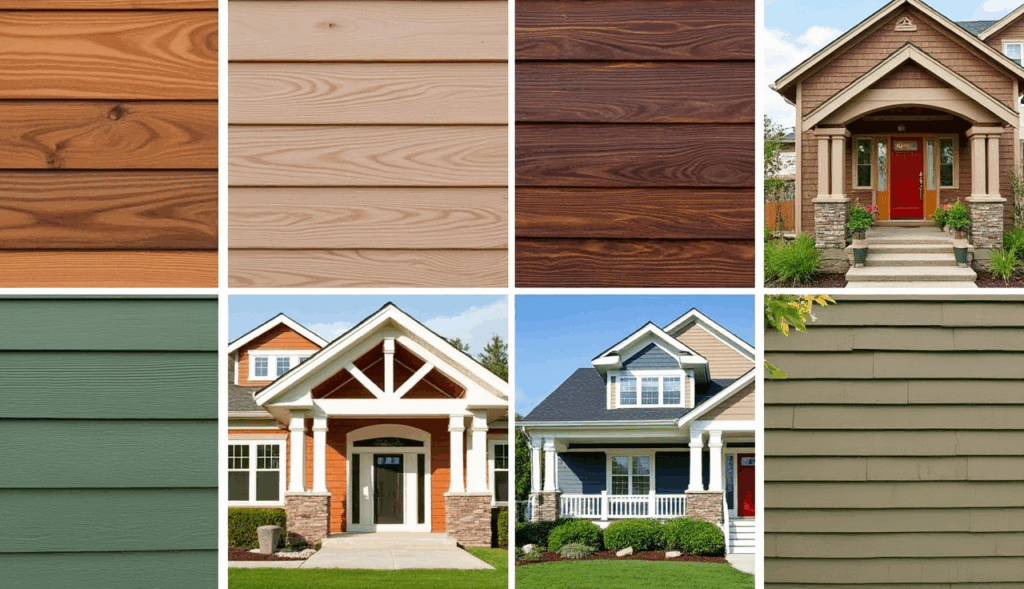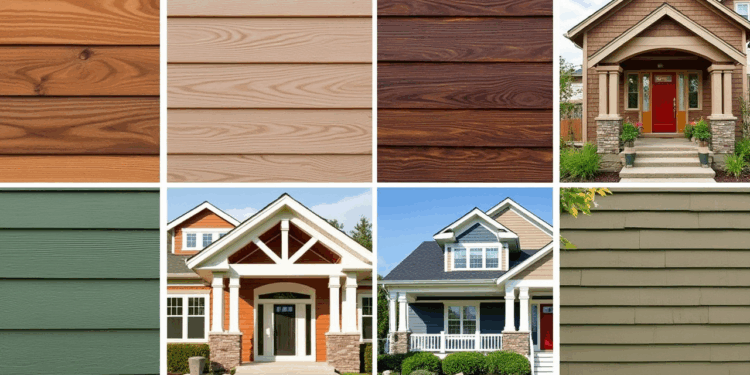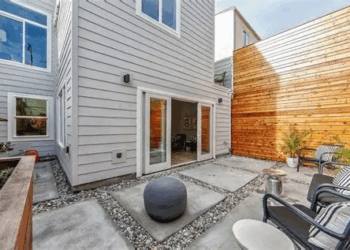
When it comes to the exterior of a building, the choice of siding material plays a crucial role in both aesthetics and functionality. From classic options like wood to modern alternatives like vinyl, the world of exterior siding materials offers a diverse range of choices for homeowners and builders.
Let’s delve into the various types, factors to consider, installation techniques, and maintenance tips surrounding exterior siding materials.
Types of Exterior Siding Materials
When it comes to choosing the right exterior siding material for your home, there are several options available, each with its own unique features and benefits. Understanding the different types of siding materials can help you make an informed decision based on factors such as durability, maintenance requirements, and aesthetic appeal.
Vinyl Siding
Vinyl siding is a popular choice for many homeowners due to its affordability, low maintenance requirements, and versatility in terms of colors and styles. It is durable, resistant to rot and insect damage, and can withstand harsh weather conditions. However, it may crack or fade over time, requiring occasional replacement or repair.
Fiber Cement Siding
Fiber cement siding is known for its durability and resistance to fire, rot, and insects. It is low maintenance and can mimic the look of wood or stucco. While it is more expensive than vinyl siding, it is a long-lasting option that can add value to your home.
Wood Siding
Wood siding offers a natural and timeless look that can enhance the curb appeal of your home. It is available in various types of wood, such as cedar, pine, and redwood, each with its own unique characteristics. While wood siding requires more maintenance, including staining or painting to prevent rot and decay, it can last for many years if properly cared for.
Brick Siding
Brick siding is a durable and low-maintenance option that can add a classic and elegant look to your home. It is resistant to fire, rot, and insect damage, and can last for decades without needing to be replaced. While it is more expensive than other siding materials, it is a long-term investment that can increase the value of your property.
Stone Veneer Siding
Stone veneer siding provides a luxurious and high-end look to your home without the cost and weight of natural stone. It is durable, weather-resistant, and requires minimal maintenance. Stone veneer siding comes in a variety of styles and colors, allowing you to create a custom look for your home.
Factors to Consider When Choosing Exterior Siding
When selecting exterior siding for your home, there are several important factors to consider to ensure you make the right choice that meets your needs and preferences.Climate plays a crucial role in determining the most suitable siding material for your home.
Different materials react differently to varying weather conditions, so it’s essential to choose a siding material that can withstand the climate of your region. For example, in areas with high humidity or frequent rain, materials like vinyl or fiber cement siding may be more suitable due to their resistance to moisture damage.Cost is another significant factor that influences the choice of exterior siding materials.
The initial cost of the material, installation, and long-term maintenance should all be taken into account when making your decision. While some materials may have a higher upfront cost, they may require less maintenance over time, ultimately saving you money in the long run.
It’s essential to consider your budget and weigh the costs and benefits of each siding option before making a decision.Architectural style also plays a crucial role in the selection of siding materials. The exterior siding of your home should complement its architectural design and overall aesthetic.
For example, traditional homes may look best with wood or brick siding, while modern or contemporary homes may benefit from sleek metal or fiber cement siding. It’s important to choose a material that enhances the visual appeal of your home and aligns with its architectural style to create a cohesive and harmonious look.
Installation Techniques for Exterior Siding
Installing exterior siding is a crucial step in protecting your home from the elements while enhancing its aesthetic appeal. Proper installation techniques are essential to ensure durability and functionality of the siding.
Step-by-Step Process of Installing Common Siding Materials
- Prepare the surface: Ensure the exterior walls are clean, dry, and free of any debris before starting the installation process.
- Measure and cut the siding: Accurately measure the dimensions of the walls and cut the siding panels to fit using a saw or specialized cutting tool.
- Install the starter strip: Begin by installing a starter strip at the bottom of the wall to provide a level base for the siding panels.
- Attach the siding panels: Secure the siding panels to the wall using nails or screws, making sure to leave space for expansion and contraction.
- Finish the corners and edges: Use corner pieces and trim to finish off the corners and edges of the siding for a polished look.
Tips for Ensuring Proper Insulation and Weatherproofing
- Use a moisture barrier: Install a moisture barrier between the siding and the wall to prevent water infiltration and protect against mold and mildew.
- Apply insulation: Add insulation material between the siding and the wall to improve energy efficiency and regulate indoor temperature.
- Seal all seams and joints: Seal all seams and joints with caulk or specialized tape to prevent air leakage and enhance weatherproofing.
Tools and Equipment Required for Installing Different Types of Exterior Siding Materials
| Siding Material | Tools and Equipment |
|---|---|
| Vinyl Siding | Vinyl siding cutter, snap lock punch, level, hammer, nails |
| Fiber Cement Siding | Fiber cement shears, circular saw, caulk gun, tape measure |
| Wood Siding | Miter saw, nail gun, chalk line, wood sealer |
Maintenance and Repair of Exterior Siding
Regular maintenance is essential to keep your exterior siding in good condition and protect your home from the elements. Different siding materials require different levels of maintenance, so it’s important to follow a schedule based on the type of siding you have.
Here’s a guide on how to identify common issues with exterior siding and the best practices for repairing damaged siding to maintain the overall integrity of your home.
Regular Maintenance Schedule for Various Siding Materials
- Wood Siding: Inspect for rot, mold, or insect damage annually. Clean and reseal every 3-5 years.
- Vinyl Siding: Wash with soapy water and a soft brush twice a year to prevent mold and mildew buildup.
- Fiber Cement Siding: Check for cracks or chips annually and repaint every 7-15 years.
- Aluminum Siding: Inspect for dents, scratches, or corrosion every year. Touch up paint as needed.
Identifying Common Issues with Exterior Siding and Solutions
- Cracks and Gaps: Seal with caulk to prevent water infiltration and further damage.
- Rot and Decay: Replace damaged boards or panels to maintain the structural integrity of the siding.
- Loose Siding: Secure loose panels or boards with nails or screws to prevent them from falling off.
- Mold and Mildew: Clean with a mixture of water and bleach to remove any growth and prevent future buildup.
Best Practices for Repairing Damaged Siding
- Assess the extent of the damage and determine if a repair or replacement is necessary.
- Match the replacement siding to the existing siding to maintain a cohesive look.
- Use proper tools and materials for the repair, following manufacturer guidelines for installation.
- Ensure the repaired area is sealed and painted to prevent further damage and maintain the overall appearance of the home.
Wrap-Up
As we wrap up our discussion on exterior siding materials, it becomes clear that the selection process involves a careful balance of practicality, cost-effectiveness, and visual appeal. Whether you opt for the timeless charm of cedar siding or the low-maintenance allure of fiber cement, maintaining your exterior siding will ensure that your home remains a sanctuary of comfort and style for years to come.
Frequently Asked Questions
What are the benefits of fiber cement siding?
Fiber cement siding is known for its durability, resistance to pests and fire, and low maintenance requirements, making it a popular choice among homeowners.
How does climate affect the choice of exterior siding materials?
Climate plays a significant role in determining the ideal siding material, as it influences factors like insulation needs, resistance to weather elements, and overall longevity.
What tools are essential for installing vinyl siding?
Key tools for installing vinyl siding include a utility knife, tin snips, a snap lock punch, and a zip tool for efficient and precise installation.
How can I prolong the lifespan of wood siding?
Regularly staining or painting wood siding, addressing any moisture issues promptly, and ensuring proper ventilation can help extend the lifespan of wood siding.














